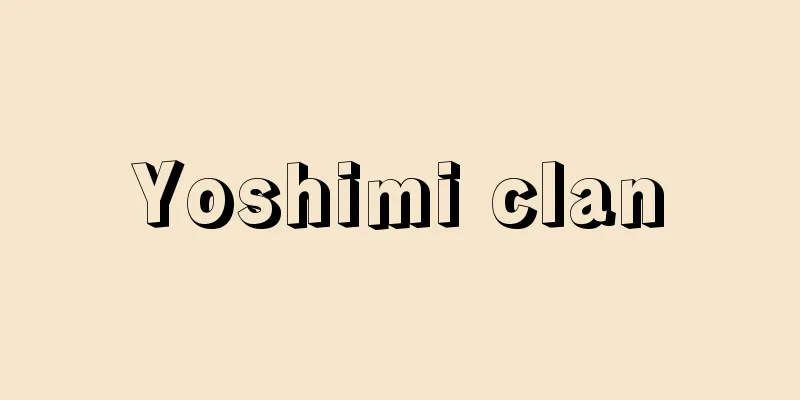Yoshimi clan

|
It began when Tameyori, the grandson of Minamoto no Noriyori (yoritomo's younger brother), ruled Yoshimi-sho in Musashi Province (Yoshimi Town, Saitama Prefecture) and called himself Yoshimi Jiro. His descendants spread to Musashi, Noto, Inaba, Iwami, and other areas, and the Yoshimi clan of Noto and Iwami are particularly famous. The Noto Yoshimi clan migrated from Musashi to Noto during the Kamakura period, and is said to have made their base in the central part of the Ochigata Rift Valley (Hakui City, Ishikawa Prefecture, and the Rokusei area of Nakanoto Town, Kashima County), but the details are unknown. During the Nanboku-cho period, Yoriaki, Yoritaka, and Ujiyori succeeded the position of Shugo of Noto, and Yoritaka also served as Shugo of Ecchu. They fought in battles in the Hokuriku region on the side of the Ashikaga clan, but it is unclear what happened to them after the end of the Nanboku-cho period. The Iwami Yoshimi clan traces its origins to Yoriyuki, who migrated from Noto to Kibe-go, Yoshika-gun, Iwami Province (Tsuwano Town, Shimane Prefecture) in the late Kamakura period, and is said to have had its castle at Sanbonmatsu Castle (Tsuwano Castle) in Nonogo, Yoshiga-gun in the same county from the time of Yorinao, but historical documents only confirm the existence of the clan from Yorihiro onwards in the mid-Muromachi period. Yorihiro controlled Yoshiga County (Tsunano Town, Yoshiga Town), and had belonged to the Ouchi clan since Nobuyori's generation, but in 1557 (Koji 3), Masayori defeated the Ouchi clan together with Mori Motonari, and was granted Abu County in Nagato Province by Motonari, expanding his territory. Thereafter, he belonged to the Mori clan, and Hiroyori married the elder sister of Mori Terumoto, and was given the two counties and more than 15,000 koku of rice. In 1600 (Keicho 5), Hironaga (Hiroyuki) moved from Sanbonmatsu Castle to Hagi (Hagi City, Yamaguchi Prefecture) following the transfer of the Mori clan to Bungo and Nagato, but his territory was reduced to one-fifth, and in 1604, he ran away and had all his territory confiscated except for his father Hiroyori's retirement allowance of over 1,000 koku. Hiroyori adopted Nariyori, the third son of Kikkawa Hiroie, a member of the Mori clan, and in 1617 (Genwa 3), Hironaga was allowed to return to the clan, but the following year he was killed by Terumoto on false charges, and Nariyori was later added to the Mori clan and took the surname Mori (Ono Mori clan), and the Yoshimi clan became extinct. [Makoto Tatehana] "Ishikawa Prefecture History, Volume 1" (1927, Ishikawa Prefecture) "Tsuwano Town History, Volume 1" (1970, Tsuwano Town History Publishing Association) Note: In the diagram, biological children are indicated with | and adopted children with ‖ ©Shogakukan Yoshimi clan (Iwami) / Brief family tree Source: Shogakukan Encyclopedia Nipponica About Encyclopedia Nipponica Information | Legend |
|
源範頼(みなもとののりより)(頼朝(よりとも)の弟)の孫為頼(ためより)が武蔵国(むさしのくに)吉見荘(よしみのしょう)(埼玉県吉見町)を領し、吉見二郎と称したのに始まる。その子孫は、武蔵、能登(のと)、因幡(いなば)、石見(いわみ)などに広がり、このうち能登、石見の吉見氏が著名。 能登吉見氏は、鎌倉期に武蔵から能登へ移住し、邑知潟(おうちがた)地溝帯の中央部(石川県羽咋(はくい)市、鹿島(かしま)郡中能登(なかのと)町鹿西(ろくせい)地区周辺)を本拠としたらしいが詳細は不明。南北朝期になると、頼顕(よりあき)、頼隆(よりたか)、氏頼(うじより)が能登の守護職(しゅごしき)を継承し、頼隆は越中(えっちゅう)の守護職も兼任した。足利(あしかが)方として北陸を転戦するが、南北朝末期以降のことは明らかでない。 石見吉見氏は、鎌倉後期に能登から石見国吉賀(よしか)郡木部郷(きべごう)(島根県津和野(つわの)町)へ移住した頼行(よりゆき)を祖とし、頼直(よりなお)の代から同郡野々郷(ののごう)三本松城(さんぼんまつじょう)(津和野城)に居城したと伝えられるが、史料上確認できるのは室町中期の頼弘(よりひろ)以降である。頼弘は吉賀郡(津和野町、吉賀町)を支配下に置き、信頼(のぶより)の代から大内氏に属したが、1557年(弘治3)正頼(まさより)は毛利元就(もうりもとなり)とともに大内氏を討ち、元就から長門国(ながとのくに)阿武(あぶ)郡を宛行(あておこな)われ所領を拡大、以後毛利氏に属し、広頼(ひろより)は毛利輝元(てるもと)の姉を妻として両郡ほか1万5000余石を領した。1600年(慶長5)広長(ひろなが)(広行)は毛利氏の防長転封(ぼうちょうてんぽう)に従い、三本松城から萩(はぎ)(山口県萩市)に移るが、所領を5分の1に削減され、1604年、出奔し、父広頼の隠居料1000余石を除き所領を没収された。広頼は毛利一門の吉川広家(きっかわひろいえ)の三男就頼(なりより)を養子とし、1617年(元和3)広長も帰参を許されるが、翌年冤罪(えんざい)によって輝元に討たれ、のち就頼も毛利一門に加えられて毛利姓(大野毛利氏)を称したため、吉見氏は絶えた。 [舘鼻 誠] 『『石川県史 第1編』(1927・石川県)』▽『『津和野町史 第1巻』(1970・津和野町史刊行会)』 注:図では実子を|で、養子を‖で示した©Shogakukan"> 吉見氏(石見)/略系図 出典 小学館 日本大百科全書(ニッポニカ)日本大百科全書(ニッポニカ)について 情報 | 凡例 |
Recommend
Paracusia Willisiana (English spelling)
...Hearing loss is conductive, and hearing tests ...
Tracy, Spencer
Born April 5, 1900 in Milwaukee, Wisconsin [Died] ...
One-line bear
〘Noun〙 A type of dark circles on the face of an ac...
"Uji Safu-ki" - Uji Safu-ki
…The diary of the Minister of the Left, Fujiwara ...
General Agreement on Tariffs and Trade
…General Agreement on Tariffs and Trade (GATA) is...
Golden algae - Golden algae
…Currently, there are approximately 30,000 known ...
Alfven wave - Alfven wave
When an external magnetic field is present within...
Da Lat (English spelling)
The capital of Lam Dong Province in south-central ...
Natsufuji (summer wisteria) - Millettia japonica
A creeping deciduous shrub of the legume family. A...
Ariès, P. (English notation) AriesP
...Recently, there have been frequent attempts to...
CT
(2) CT a.The device can easily and non-invasively ...
The Kiyō Agreement
A treaty concluded between the So clan of Tsushima...
Heliodorus - Heliodorus (English spelling)
Date of birth and death unknown. Ancient Greek no...
Novathaca schencki (English spelling) Novathacaschencki
…[Tadashige Nabe]. . … *Some of the terminology e...
Akiyoshi Mountain Building
Mountain building in Japan in the mid-Triassic per...









